#cdc covid guidelines update
Explore tagged Tumblr posts
Note
About covid being over: are we just meant to put our entire social lives, our entire society on pause forever? My mental health plummeted during lockdown and will take years to recover. Now that there's vaccines and crowd immunity and less deadly strains we ARE meant to learn to deal with it as a given, the way we have with many deadly diseases in the past, and move on. So for the sake of life moving on at some point it's **normal** to treat it as a cold, and I'm saying this as someone who's lost people during the pandemic too. Please do not fear monger.
No, but you SHOULD care about other people enough to still mask.
I am NOT fearmongering.
Covid is still dangerous, especially to the many MANY people who are immunocompromised and people who cannot get the vaccines (for whatever reason).
I know several people who THIS YEAR caught permanently disabling covid, despite all being fully vaccinated.
I am not saying you have to quarantine yourself anymore. That was NOT a thing I said. There is a world of difference between wishing that other people cared enough to MASK, a thing that is NOT HARD AT ALL, and demanding that people still observe full quarantine protocols.
Plugging your ears and closing your eyes and refusing to listen when people are still justifiably worried, and not listening to experts that haven't been pressured by the government to say 'COVID IS NOT A THREAT ANYMORE YAAAY!!!' just makes you a fool.
I know that's harsh, but it's the truth.
Hospitals are no longer required to report covid cases and covid deaths as such. This is a GIANT RED FLAG that people are happily ignoring so they can feel safe.
#i am so tired#i'm never going to be able to go anywhere without a mask again#and people like this are why#current events 2023#america#WEAR A MASK#you don't have to quarantine yourself#but please WEAR A MASK#it's the least you can do#the very least minimum bar to prove you give a damn about other human beings#i resent being framed as hysterical over this#anyone got a copy of that one post with updated covid guidelines recommended by the peoples CDC (i think that's the org?)
625 notes
·
View notes
Text
August 20, 2024 @Imani_Barbarin
Transcript:
"Remember when disabled people were trying to warn everybody that the politicization of the CDC and the complete erosion of public health would impact everyone eventually? Well, news just came out that the CDC guidelines have been updated so that students with lice no longer need to be sent home early.
…......
Right?
The CDC is ACTIVELY weakening its guidelines on lice so that students with lice can remain in school. Now, why would they do that, right? 'Cause children missing school in a vacuum is not necessarily a bad thing, particularly when they're trying to prevent the spread of something like lice -- or COVID but hey, YOU all don't wanna talk about that anymore, right?
But it's because you all work and they don't want you staying home from work, so they'll expose your children to lice in order for you to stay in work, for you to make those ducats, right? For corporations and billionaires.
If this is something you can tolerate -- feel free, right? But these loosening guidelines don't just stop with lice. They are running down the list of things, so that it harms and impacts your children, your families and your communities, and disabled people have been saying this from the beginning -- that it won't just stop at COVID because disabled people are "disposable", but it'll impact every single thing.
And now, we have a rise in monkeypox, 'cause there's another variant going around, and that has a 10% fatality rate."
#slow motion car crash with multiple vehicles#and some of those approaching vehicles are carrying highly flammable gas#if you think this isn't a big deal because lice isn't deadly please for the love of god LOOK at the bigger picture#the warning sirens started blaring years ago when covid infection/disability/death started being normalised#as an inevitable part of ''living your life'' (to serve the wealthy)#sars cov 2#mpox#capitalism#etc etc etc#twt#tt#vid
334 notes
·
View notes
Text
3 COVID Experts on Why the CDC’s Isolation Guidelines Are Bad for Public Health
You can still be contagious if you’re fever-free and feeling better.
Article Date: March 7, 2024
Article Blurb:
Given that COVID is still very contagious, Lara Jirmanus, MD, MPH, a clinical instructor at Harvard Medical School and fellow at the FXB Center at the Harvard T. H. Chan School of Public Health, says the newest guidelines are more confusing—and that they’re even misleading. She tells SELF that the CDC’s messaging implicitly communicates two falsehoods: that COVID has “ceased to be a threat,” and that it “stops being transmitted when people stop having a fever.” According to Dr. Jirmanus, infectiousness has little to do with specific symptoms, since you can be sick (and contagious) without a fever and with few, mild, or even no symptoms at all. And if you’re testing positive on rapid tests, you’re very likely still able to infect others, even if you feel fine.
[...]
“Shortening isolation below five days supports economic interests and is not in the interest of protecting health, as the contagious period can vary with current variants,” Kaitlin Sundling, MD, PhD, director of cytology at Wisconsin School of Medicine and Public Health and member of the People’s CDC, tells SELF. She believes that the CDC’s updated recommendations are moving in the wrong direction. “COVID isolation should be expanded, not reduced or eliminated. There is no change in the scientific evidence around COVID transmission that would support reducing the recommended isolation period below five days,” she says. “Extending isolation beyond five days would be a safer approach, both to prevent viral spread and to allow people adequate time to recover.”
Despite what the CDC guidelines say, Dr. Sundling’s advice is to isolate for 10 to 14 days, if you have that option, and take two rapid tests with negative results at least 24 hours apart before going about your daily life as usual again. (Because Americans do not have universal paid sick leave, Dr. Sundling recognizes that many people will have to return to work or other responsibilities earlier than this. In that case, she says, people should be “wearing a well-fitting respirator and limiting in-person activities only to what is essential.”)
125 notes
·
View notes
Text
click above to add your name to the letter to tell the CDC to put people over profit when it comes to covid
#disability#immunocompromized#ableism#cdc aka capitalist death cult#cdc aka covid distribution committee#covid cautious#me/cfs#long covid
231 notes
·
View notes
Text
While public appetite for Covid news is low, experts say the stakes for communicating about respiratory illnesses are deceptively high. An ongoing bird flu outbreak and a small but deadly swine flu outbreak in Colombia this year have public health experts worried that another flu pandemic is all but assured in coming years. As government officials downplayed Covid, flu, and other deadly viruses in recent years—shortening Covid isolation times and lifting restrictions—misinformation about measles, another respiratory illness, has proliferated. A massive measles outbreak is currently roiling Europe, and Florida has now reported multiple cases at a single school. State officials who rose to prominence by opposing Covid measures said the 200 unvaccinated students who had been exposed did not need to quarantine.
Then there is the threat of more novel viruses; dangerous new coronaviruses have emerged every seven to nine years in the past two decades, which means we may be soon see another. In the meantime, Covid is still hospitalizing and killing people even with current guidelines; it could get worse when people are urged to move more freely while contagious.
In theory, we should be better equipped than ever before to counter these threats. “Covid has elevated the amount of access and information and awareness that we have [of] seasonal respiratory viruses,” said Erin Sorrell, senior scholar at the Johns Hopkins Center for Health Security. Covid taught us that these respiratory viruses can be airborne, that asymptomatic people can still infect others, and that the time it takes to stop shedding the virus can vary widely; we also learned what we can do to lessen these challenges.
The CDC has yet to make the proposed changes public—or even confirm the Post’s report. When I contacted the agency for comment on this piece, a spokesperson responded that there are “no updates to COVID guidelines to announce at this time,” and the agency “will continue to make decisions based on the best evidence and science to keep communities healthy and safe.” But the guidelines outlined by the Post’s three sources would run counter to the available research on Covid and other respiratory illnesses—presumably in order to satisfy economic and political interests. The consequences both for contagion and public trust, should the agency follow through on these plans, could be severe.
187 notes
·
View notes
Text
Also preserved in our archive
By Isaac Ocean
7 amazing ways one-way masking keeps you safe during covid
Let’s face it – we’re all tired of talking about masks. But here’s the tea: one-way masking is a real game-changer for staying healthy, especially as COVID continues to circulate in 2024. Whether you’re the only one rocking a mask at your local coffee shop or braving a packed concert, one-way masking can offer significant protection against airborne illnesses, COVID included. The inside scoop? Wearing a high-quality mask solo—like a KN95 or N95—means you’re taking control of your own health, even if others around you aren’t masking up. In crowded places, this solo mask mission can dramatically reduce your exposure risk, making it well worth the extra step to stay protected.
The solo mask movement is taking off, and here’s why Gone are the days when everyone was masked up like they were extras in a medical drama. Now, it’s all about taking control of your own health journey. One-way masking means wearing your mask even when others aren’t – and yes, it actually works! Think of it as your personal force field against those pesky respiratory droplets floating around.
Level up your protection game with these mask hacks Want to know the secret to maximum protection? It’s all about that high-quality mask life. Here’s the breakdown of what you need:
N95 masks: The heavyweight champion of personal protection
KN95 masks: The popular alternative that’s almost as fierce
Surgical masks: The reliable backup dancer
Cloth masks: The basic option (but make it fashion)
The receipts: why one-way masking is a total vibe
Let’s spill the scientific tea on masks and travel safety. Research reveals that wearing a mask on planes can cut your infection risk by more than half when you’re seated near someone who’s unwell—COVID or not. Think of it as a bodyguard for your respiratory system! And here’s where it gets even more interesting: wearing a KN95 or N95 mask alone offers significantly better protection than if both you and the person next to you are wearing standard blue surgical masks. This is especially crucial as COVID cases continue to fluctuate and travel restrictions ease, increasing exposure risks. So, whether you’re in a crowded airport or a packed plane, strapping on a quality mask can be one of the most effective defenses against airborne illnesses, COVID included.
Your ultimate covid defense starter pack Ready to level up your protection game? Here’s what you need in your arsenal:
A stash of high-quality masks (we’re talking N95s or KN95s) Your vaccine card showing you’re fully boosted A sixth sense for avoiding packed indoor spaces Hand sanitizer (obviously) A can-do attitude about keeping those germs away
The secret sauce: making one-way masking work for you
Here’s how to absolutely slay at one-way masking:
Check that seal! No gaps means maximum protection Keep it clean and dry (wet masks are so last year) Replace your mask regularly (treat yourself to a fresh one) Rock it with confidence (masks can be a lewk) Remember: something is better than nothing
Living your best masked life: the extra steps that matter
Want to really step up your protection game? These bonus tips will have you covered:
Upgrade your home’s ventilation game with HEPA filters Master the art of the elbow cough Perfect your hand-washing routine (20 seconds minimum) Know when to take a sick day (listen to your body) Stay updated on the latest CDC guidelines
The bottom line: why one-way masking is here to stay Look, we get it – being the only one wearing a mask can feel awkward. But here’s the thing: protecting yourself isn’t just smart, it’s iconic. One-way masking gives you the power to take charge of your health, regardless of what everyone else is doing. It’s like having a superhero shield that you can whip out whenever you need it.
Remember, you don’t need everyone else to mask up to stay protected. With the right mask and proper fit, you’re already doing amazing, sweetie. So go ahead, rock that mask with pride – your immune system will thank you later.
Pro tip: Keep a variety of masks in rotation so you can match them to your outfit or mood. Because if you’re going to protect yourself, you might as well serve looks while doing it.
Stay safe, stay stylish, and keep slaying the one-way masking game. Your health is the ultimate trending topic, and you’re the main character of this story.
#mask up#covid#pandemic#public health#wear a mask#covid 19#wear a respirator#still coviding#coronavirus#sars cov 2
43 notes
·
View notes
Text
Bestiaryposting Results -- Gligglae
Sorry this is later than usual; traveling for the holidays makes it difficult to keep up with this sort of thing. The smart move would have been to write it up a couple days ahead of time, then on Monday just update it with anything new that had been posted since, but see, what happened was that I did not do that. Instead, I tried to type this up Monday evening in between various family obligations, realized I didn't have time to do it properly, and just shoved it in my drafts. Then all of Tuesday was taken up with the long drive back home from where my family lives, and now you're getting it on Wednesday.
(Also, don't worry, I followed all CDC guidelines appropriate for someone who had recently had covid, and wouldn't have traveled for the holidays at all if I hadn't been without a fever for 48 hours prior to departing. Plus I drove instead of flying, didn't visit anyone but immediate family, and had a mask the whole time, so even if I am still contagious somehow, exposure was pretty minimal.)
Anyway, the entry that our artists are working from is here:
And, of course, all previous material on this matter can be found at https://maniculum.tumblr.com/bestiaryposting.
I think a larger number of people than usual identified the animal in question right off the proverbial bat, because this one has some pretty blatant tells, but as always I appreciate everyone trying to put it out of their minds.
So, anyway, in rough chronological order:

@coolest-capybara (link to post here) (thank you for providing your own alt text, I really appreciate it) brings us her usual impeccably medieval-stylized rendition -- the swirls and curves in this one give it a really interesting vibe, I think. We can see the Gligglae in full-body profile on the left there, and a group of them doing their cluster behavior on the right. The, like, griffin/cockatrice/vampire look is pretty great, also. I enjoy the overall design, which you can find some discussion of in the linked post. Gold foil also a nice touch.
Coolest-capybara also notes that the entry is very interested in the ways in which the creature is "almost, but not quite, entirely unlike a bird," and I can explain why that is. It is because this entry is in the Bird section of the bestiary, so officially this is a bird -- I mean, it flies, what else can it be -- but it's sufficiently un-bird-like that it really sticks out to the authors, so they need to explain the ways in which it's Doing Bird Wrong. Everything else in this section does X, so we need to point out that this one does Y, kind of thing.
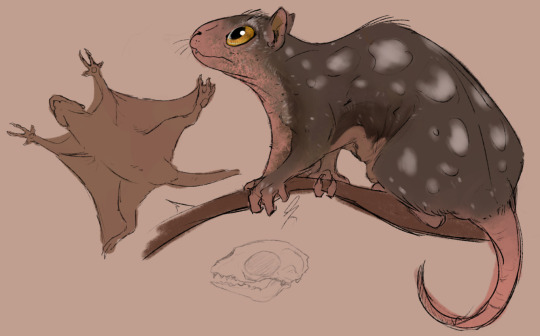
@silverhart-makes-art (link to post here) has drawn an absolutely adorable little Gligglae. (Adorable if you have my sense of aesthetics, that is -- I suspect if you're among the portion of the population that finds aye-ayes more creepy-looking than cute, that might apply here as well.) There's an explanation of design decisions in the linked post, including a number of references to real animals that provided inspiration. I like the decision to play up the "lowly" and "mean" part of the description by making it small and kind of scruffy. And the general concept of blending "gliding rodent" with "nocturnal primate" to make an arboreal mammal with elements of both really worked out well here, in my opinion.

@aethereaii (link to post here) has done this beautiful piece in a style that kind of gives "19th-century naturalist" vibes. (Actually, it makes me think of James Gurney, but I suspect that association says more about my childhood reading habits than anything else.) This is a great design in my opinion, and you can find some brief discussion on design decisions as well as an earlier version of the Gligglae in the linked post. The earlier design is also very good, but I agree with Aethereaii that this one is a step up, particularly with the Anomalocaris-inspired faux-wings. I also really like the inclusion of the juvenile Gligglae (Gligglings?) clinging to their parent's back in the corner there.

@karthara (link to post here) decided to go in a reptilian direction with this one, which (a) works well and (b) caused me to spend a chunk of time reading about flying snakes on Wikipedia just now. So in this version, the "rowing motion with its skin" is a description of the Gligglae flaring its ribs and undulating through the air -- which I genuinely think really makes sense. The entry seems to legitimately disagree with itself about whether this critter has wings (or, taking it entirely literally, it has wings but flies through a completely separate method that specifically does not involve said wings, which I think we're justified in deciding is Wrong), so I think going with such a non-wing-like flight method works here. Also like the concept of making these very cuddly (and apparently loving, according to our bestiary author) creatures into a type of animal that usually isn't seen that way. The linked post also contains some brief notes on design decisions.
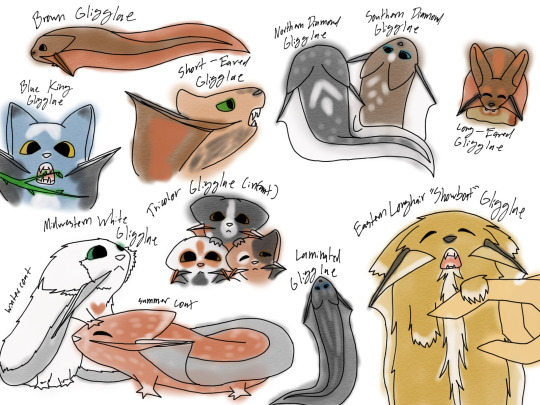
@strixcattus (link to post here) has, as per usual, provided a really excellent modern-naturalistic description of the creature they've designed in the linked post, and you should definitely go check it out right now. I'll wait.
... back? Okay good. I particularly like their interpretation of the "grape-cluster" behavior as a social group that's specifically not a kin group; and also the fact that said group is officially referred to as a "cuddle". The choice to make it a whole genus and show us several different wild and domesticated species, also very good, love it. As with several of these drawings, Strixcattus's Gligglae (Gligglaes?) are extremely cute -- which, really, does also fit the description provided in the entry. They're like tadpoles crossed with sugar gliders.
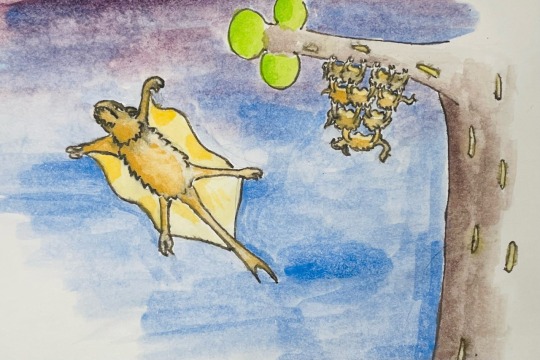
@cheapsweets (link to post here) credits Ken Sugimori's Pokemon illustrations as a stylistic inspiration, which I suppose explains why the Gligglae cluster seems to be hanging from a Sudowoodo. The linked post also draws certain parallels between medieval bestiaries and the Pokedex, which I think is actually pretty insightful. There's also a breakdown of their design decisions there, go read it. I think this is a pretty good rendering of something that is like a flying squirrel but distinctly not a flying squirrel, and I like the shaggy look of the fur.
Also, thank you for providing your own alt text.
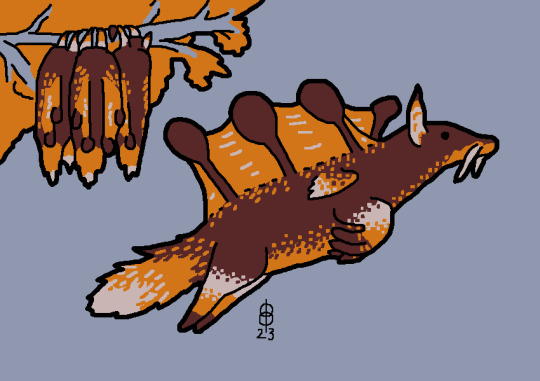
@pomrania (link to post here) is, I think, the only person to take the bestiary author at their word that this animal has wings but flies through some other, non-wing-related method. You can see the tiny useless wings at the shoulder there. I really think that's fascinating as a concept: what evolutionary pressures would produce an animal that (a) has wings and (b) flies but (c) those two things are unrelated? Although this many appendages on a fur-bearing creature puts us firmly in the "alien biology" territory, so maybe it's silly to expect it to make sense by the standards of terrestrial biology. Regardless, I like it, and I think the decision to run with the "rowing" description by giving it those oar-shaped appendages is a good & creative one. The post linked above contains a fair bit of information on design decisions and the drawing process here -- there are sketches and everything.
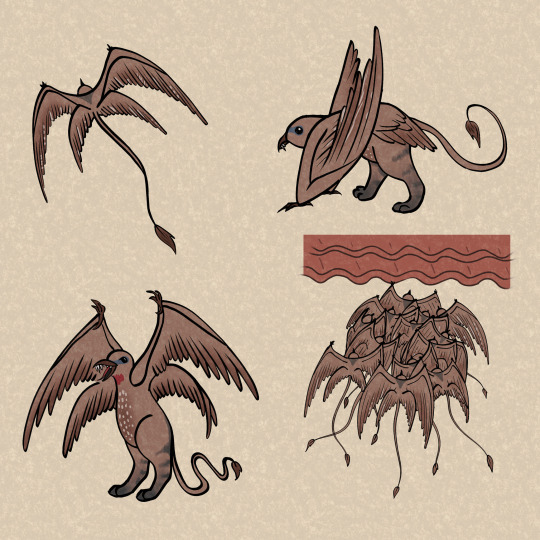
@vindikat (link to post here) has interpreted this in a way I find really charming. The art is of course excellent, very well drawn, and I appreciate the effort that went into doing these different poses. However, I really like it from a worldbuilding perspective: this gives me the impression of a small species of griffin that's adapted to urban living, more pigeon/cat than eagle/lion. (Come to think, both pigeons and cats are examples of feral populations finding a successful niche, rather than wild ones that adapt to a city, so maybe we can speculate that these guys are also descended from domestic ancestors.) Also the Gligglae under the eaves there remind me of pictures of chimney swifts that have made the rounds on Tumblr.
The design is also generally very appealing; I think the extra wings and the long tail really work here. The linked post includes an explanation of the design decisions that I think is worth taking a look at.
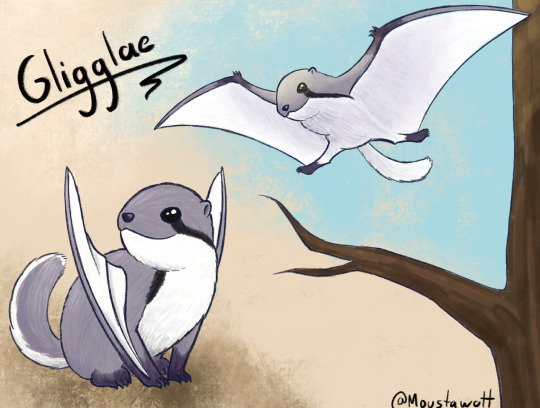
@moustawott (link to post here) has given us another very cuddly version of the Gligglae. I particularly like the wing design here, how it's kind of a mammalian version of a pterosaur -- Moustawott indicates that they were specifically trying not to draw the animal that they're sure this is, and I think the pterosaur-squirrel design here is a great way to make something that could fill kind of the same niche while being an unmistakably distinct creature. The little round head and eye markings remind me of a chipmunk, also, which is cute.

@rautavaara (link to post here) continues to do interesting stylistic stuff with their contributions. I like how the limited color palette here makes this look kind of like a single-block woodcut or similar relief printing. Like, you could plausibly see this as a design someone's carved into a wood block, then printed on mustard-yellow paper with purple ink. (I'm actually not 100% sure that's not what it is; I would just be surprised if someone actually went the extra mile of breaking out the engraving tools for my little bestiaryposting thing.) Very dynamic scene, also, and a charming creature design; love the huge mouths with pointy little fangs.
All right, these are all the ones that come up on the search; if I missed yours, let me know please.
(I have to apologize here for another delay that's absolutely my fault -- I would have had this out a few hours ago, but I got derailed by impulsively deciding to check out that Hbomberguy plagiarism video everyone's talking out, and... yeah.)
Anyway, as a number of this week's artists indicated, this one was really easy to guess, so the reveal seems a little pointless, but we have a format, so:
Obviously, this was the sheep.
What? Look, you can't make assumptions with these things. Some of these medieval bestiary entries are really counterintuitive. Medieval Europeans believed there was a species of small, highly-social, flying nocturnal sheep native to Ethiopia.
Really, it's in Pliny the Elder.
...
Yes, fine, I'm just lying to you for fun. It's the animal you all think it is, there are no flying sheep to my knowledge. Here's the Aberdeen Bestiary illustration.

Yep, it's the bat. Oddly human face on that one, and generally I don't think this was drawn from life, but it's definitely a bat.
I do kind of find the way it's described in this entry kind of interesting, though. The confusion about whether bats count as having wings (even after having been placed in the "bird" category) is kind of odd, and the "rowing" description is not one I would have ever thought of. I very much like the declaration that the way bats huddle together is "an act of love of a sort which is difficult to find among men"; it's a sweet way to talk about a creature with a generally negative reputation, which contrasts interestingly with the fact that the author also thinks of them as "lowly" and "mean". You kind of get the idea of a creature that's a bit wretched but in a sympathetic way. "Scrungly", one might say.
101 notes
·
View notes
Text

HOLLYWOOD, CA — At a press conference this week, Sony producers announced the production of a new modern adaptation of George Orwell's dystopic novel 1984 that will feature the character of Big Brother as the good guy.
"We felt like it was time to update the story to fit a modern audience," Sony producer Glen Maxwell told reporters. "After seeing how censorship and totalitarianism have grown in popularity over the past few years, we think Big Brother is probably a better protagonist than Winston Smith. Big Brother's insistence on absolute compliance fits better with current progressive ideals."
The film will feature a sympathetic Big Brother working with the state to better the lives of millions by implementing strict adherence to DEI policies, CRT teachings in schools, and CDC guidelines throughout society.
"After seeing how much people craved rules and control during the Covid pandemic, we decided it wouldn't accurately depict what society looks like right now to have a protagonist who goes against the state narrative," Maxwell commented. "I mean, we didn't have to do much with the script, we just used a bunch of Anthony Fauci quotes from the past few years and filled in the blanks. ‘I am the science.' Pure Big Brother gold!"
The film is set to release next year and will star Mark Ruffalo, with a supporting cast including George Takei and Susan Sarandon, and will be directed by Rob Reiner.
74 notes
·
View notes
Text
The WHO has recently released documents referencing a new COVID variant, JN.1 and a reiteration of recommendations. Now, for my American followers, it is important to note that CDC guidelines have not changed nor has any update been released from the CDC.
First, it is important that we go over current prevention methods the CDC recommends:
Stay up to date with COVID vaccines
Improve Ventilation
Get tested for COVID-19 if needed
Follow recommendations for what to do if you have been exposed
Stay at home if you have suspected or confirmed COVID
Seek treatment if you have COVID and are at high risk or serious illness
Avoid contact with who have suspected or confirmed COVID
Follow current basic hygienes guidelines (washing hands regularly, staying home when sick, coughing and sneezing into your elbow, etc.)
Now, just because there is a new variant of interest does mean that people need panic and go back into a global shutdown. The number of new cases has increased in the past 28 day period, but the number of deaths has actually decreased indicating less serious infections. COVID is still to be taken seriously and people still need to stay up to date on their vaccinations, but there is no need to panic.
71 notes
·
View notes
Text
The People’s CDC COVID-19 Weather Report: October 28, 2014
The People's CDC has released another updated report on COVID-19 data and action items for the United States of America.
Highlights:
Wastewater and emergency room data indicate covid transmission continues to be under-reported. Get vaccinated and use layers of precaution such as masking and air filtration to defend yourself from infection.
KP.3.1.1 remains the dominant variant.
The CDC has updated guidelines permitting access to twice-annual covid vaccines for adults aged 65 and older, as well as the immunocompromised.
Read the rest of the report here:
Please note that the CovidSafeCosplay blog and its admin are unaffiliated with the People's CDC or its management, and are simply sharing the resource.
Via the People's CDC About page:
The People’s CDC is a coalition of public health practitioners, scientists, healthcare workers, educators, advocates and people from all walks of life working to reduce the harmful impacts of COVID-19. We provide guidance and policy recommendations to governments and the public on COVID-19, disseminating evidence-based updates that are grounded in equity, public health principles, and the latest scientific literature. Working alongside community organizations, we are building collective power and centering equity as we work together to end the pandemic. The People’s CDC is volunteer-run and independent of partisan political and corporate interests and includes anonymous local health department and other government employees. The People’s CDC is completely volunteer run with infrastructure support being provided by the People’s Science Network
11 notes
·
View notes
Text
I thought Fauci was hospitalized with the WEST NILE virsus? "Fauci wants to bring back MASKS after contracting COVID (despite being vaccinated SIX times)"

12 Aug 2024
By Alexa Lardieri U.S. Deputy Health Editor Dailymail.Com
The number of infections is increasing as part of another summer surge - even though hospitalizations and deaths from the virus remain at historic lows.
On Monday, the former director of the National Institute of Allergy and Infectious Disease said: 'The message is that if you are in a risk category you have got to take this seriously.'
The 83-year-old told people with comorbidities and seniors 'you should be wearing a mask' in crowded places.
He also revealed he had contracted Covid about two weeks ago. It was his third Covid infection and he has been vaccinated and boosted a total of six times.
The above shows weekly Covid deaths (blue bars) and percent positivity of Covid tests (orange line)
The above shows the percent positivity of Covid tests in the past week by region in the US
According to the CDC, the weekly Covid test positivity for the week ending August 3 was nearly 18 percent, compared to 16 percent the prior week and 10 percent one month before that.
Test positivity is the share of Covid swabs taken that come back positive.
World Health Organization officials warn that if the virus continues to spread, it could lead to new mutations and severe infections that evade vaccine protection and therapeutics.
Deaths have been generally on the rise since May, but began declining the week ending July 20. They currently hover at around 500 per week, compared to more than 25,000 in the fall of 2020.
The elderly, people with compromised immune systems and those with comorbidities are more at risk of developing severe Covid, being hospitalized and have a higher risk of death from the virus.
New documents 'credibly show' Covid DID leak from Wuhan lab, say House Republicans
Dr Fauci told MedPage Today Editor-in-Chief Dr Jeremy Faust: 'You don't have to immobilize what you do and cut yourself off from society, but regardless of what the current recommendations are, when you're in a crowded closed space and you're an 85-year-old person with chronic lung disease or a 55-year-old person who is morbidly obese with diabetes and hypertension, then you should be wearing a mask.
'And you should be careful to avoid crowded places where you don't know the status of other people and you should get vaccinated and boosted on a regular basis.'
Dr Fauci's face mask guidelines have long been criticized as people claimed they did not work to prevent the spread of Covid.
The educational and social effects of face masks on children have been well documented, with one NIH study calling the impact of mask use on students' literacy and learning 'very negative.'
Another NIH study also found that social distancing caused 'depression, generalized anxiety, acute stress and intrusive thoughts.'
And in testimony to Republicans in June, Dr Fauci admitted he didn't remember reading anything to support that masking kids would prevent COVID.
When asked if masking kids was an effective way of preventing Covid transmission, he said: 'I still think that's up in the air.'
Despite the mixed guidance, experts are still concerned about the rapid spread.
Dr Ashish Jha, dean of Brown University's School of Public Health and former White House Covid response coordinator, told NBC: 'If you just talk about infections, this is probably going to end up becoming the largest summer wave we’ve had. It’s still not as big as the winter waves, but it is starting to get close.'
Dr Anthony Fauci recommended that the elderly and people with comorbidities wear face masks to protect against Covid
Dr Jha said she expects this surge to peak in the next few weeks and subside in September, just as updated vaccines to target the KP.2 strain of Covid become available.
Additionally, in a briefing last week, World Health Organization officials said 84 countries are experiencing a rise in the percentage of positive Covid tests over the last several weeks.
WHO officials said: 'Covid-19 infections are surging globally... and are unlikely to decline anytime soon. The UN health agency is also warning that more severe variants of the coronavirus may soon be on the horizon.'
And wastewater surveillance suggests the spread of the virus is two to 20 times higher than what is currently being reported.
WHO officials added that new waves of infection could spur mutations and more dangerous strains of the virus 'that could potentially evade detection systems and be unresponsive to medical intervention.
The health agency is urging countries to ramp up their vaccination efforts and promote yearly Covid vaccines for high-risk individuals.
Dr Maria Van Kerkhove, an infectious disease epidemiologist and lead of the COVID-19 response at WHO, said: 'As individuals it is important to take measures to reduce risk of infection and severe disease, including ensuring that you have had a COVID-19 vaccination dose in the last 12 months, especially, if you are in an at-risk group.
'I am concerned with such low coverage and with such large circulation, if we were to have a variant that would be more severe, then the susceptibility of the at-risk populations to develop severe disease is huge.'"
#west nile virus#sars cov 2#anthony fauci#infectious diseases#CDC#masks#WHO#fauci lied#do no harm#covid
17 notes
·
View notes
Text
The Weather
30 US states remain at High to Very High levels of SARS-CoV-2 detected in wastewater since February 9, 2024, with multiple states not reporting. Preventing the spread of COVID by taking precautions like masking and improving your indoor air quality can strongly reduce your chance of infection.
We would also like to note that the CDC, which usually updates their wastewater data on a weekly basis, has not updated their dashboard since Friday, February 9th. It is significant that this data delay arrives during the same week of the announcement that they are considering making cuts to the 5-day isolation guideline. We would like to urge the CDC to make their data release schedule public and to continue to provide wastewater information in a timely and consistent manner.

Despite regional declines in wastewater levels in the Midwest, Northeast, and West, the South is still trending extremely high, almost double the national average. This is especially concerning since 7 of the 10 states to refuse Medicaid expansion are located in the South, a region home to some of, “the largest Black populations in the US.” Our collective fight against the state’s abandonment of pandemic protections is a fight against racial injustice.
As a reminder, the last two weeks are provisional data, indicated by a gray shaded area on the graph, therefore these values may change as additional wastewater sites report data. We want to remind you that multiple layers of precautions can protect against a COVID infection.
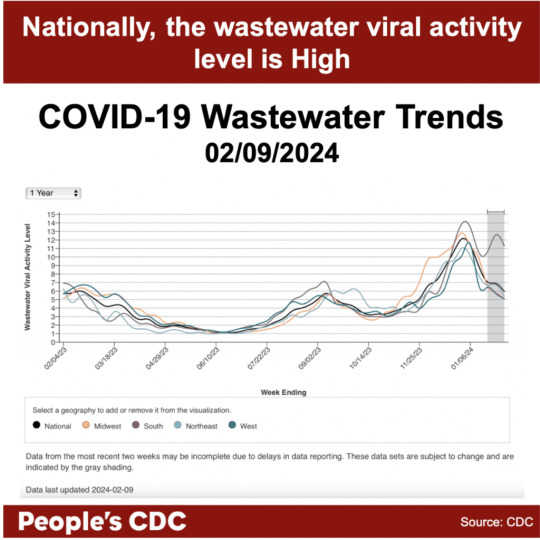
Variants
JN.1 remains the dominant variant in the United States, and is projected to make up 96.4% of cases in the next two weeks. HV.1 is projected to drop even further 1%, and all other variants are estimated to make up less than 0.6% or less each.
Remember to check estimates for your specific HHS Region for more accurate projections of JN.1 prevalence in your own community.
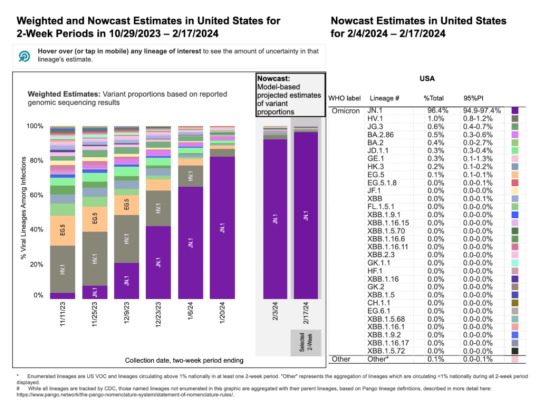
Take Action
This week is a fast moving train when it comes to demanding equitable pandemic responses and protections from the CDC and public policy. Follow the campaigns below for ways to tap in, sign on, and get involved! And don’t forget to share these with your loved ones as well.
This week the CDC announced they’re considering a change in isolation guidelines for people with COVID, removing the 5 day isolation in order to take the pressure off of American citizens who can’t afford to stay home due pressures from work, lack of paid time off and childcare expenses.
Dr. Lara Jiramanus of The People’s CDC who was interviewed expressed that “frankly, there has been no change in the science. Most people continue to be shedding virus for about nine days, with a range of six to 11 days. Younger patients will tend to be infectious for maybe one day less than that. Older patients or people with severe disease can shed the virus for a longer time.” She further elaborates in conjunction with People’s CDC press release from February 14th that “public health policy should put people first, not billionaires. Rather than ending isolation, the US should ensure paid sick leave for all.”
The CDC’s isolation guidelines impact what reasonable accommodations we can ask for at work, at school, and in hospitals as well as our legal rights should we become held in interactions with police, in jails and in prisons. It is important for all of us on a human rights level that these guidelines reflect proper research and science.
Join us in echoing this call for mandated paid sick leave for all instead of an end to isolation guidelines to Biden and Congress. The CDC’s proposal to eliminate isolation is counter to medical science and the White House must not accept it. Call the White House Comment Line Tuesday – Thursday 11-3 ET at 202-456-1414 and the Congressional Switchboard at 202-224-3121. Making calls is especially important between now and the end of March. For more information and a proposed script, follow this link. Stay tuned to our substack and social media for announcements of more actions in the next two weeks.
Additionally, ACIP, the Advisory Committee on Immunization and Practices will hold their next meeting online on February 28th and 29th.
Scientific evidence indicates updated vaccines should ideally be allowed, available, and fully covered by public funds and/or insurance, for people of all ages at least every six months.
Current vaccine uptake is low due to barriers such as lack of education, the recent diversion of the vaccine program through insurance companies, and pharmacies’ uneven participation in the CDC’s Bridge Access Program, which is due to end December 31st, 2024. Even those who did receive the updated vaccine in the fall may not have adequate protection under the annual vaccine strategy, as vaccine efficacy wanes significantly four to six months following vaccination.
A more frequent vaccination approach and frequent updates to match current variants is needed to better protect all of us amid year-round COVID infections. Follow this link for guidance on submitting a written or oral public comment no later than this Thursday, February 22, 2024 at 11:59 ET to make demands for the above.
Last month the CDC kicked the horrible and unsafe new hospital infection control guidelines it was considering back to the advisory committee (HICPAC) that had proposed the draft guidelines.
Bad guidelines have been delayed, and the next fight over them will hopefully be on a more level field, and hopefully in a process that is at least in some ways more transparent.
Public health advocates have gained another round in this fight, and we’ll need your help! You can start by signing this new petition by National Nurses United that demands that HICPAC ensure the input of frontline healthcare workers, labor unions, patients and community members, and experts in occupational health, industrial hygiene, aerosol dynamics, respiratory protection and infection prevention is central in their next round of revisions.
Additionally, please use our action network letter and call-in toolkit to write to the president, your governor, and state and federal representatives to demand that they bring back masking in healthcare and utilize all measures of infection control that are currently available to us. Don’t forget to customize letters to your own experience! For more information on how COVID spreads in hospitals and the impact of nosocomial, or healthcare-associated, infections check out our article on substack.
MoveOn has started a petition to the Biden Administration, the Department of Health and Human Services and to Congress to bring back free PCR tests for all and to increase the number of free at-home rapid antigen tests. After the end of the Federal Health Emergency for COVID in May 2023, everyday people were stripped of the resources and support they needed to manage community care and health. Even with insurance, insurers are no longer required to cover the costs of testing, pushing the most reliable form of testing for early detection, Polymerase Chain Reaction (PCR) tests, out of reach for many. Sign this petition to return fast, prevalent, and free testing tools to everyone equitably.
On a more regional note, those living in New York State are urged to customize this letter to tell their representatives and NYS Governor Hochul to continue to fund the COVID-19 Sick Leave program instead of disposing of it in the FY 2025 budget as is currently proposed. If the governor’s current budget proposal goes through, New York citizens would be forced to rely on state minimum sick leave policies of 5-7 days, meaning one COVID infection would easily meet or exceed sick leave allotments for the entire year. Additionally those who do not work in settings that meet the conditions of qualification to enforce the state’s sick leave policy would be left without any leave at all.
Finally, we must remember to keep calling our elected officials to demand a ceasefire in Gaza and to continue to wear and require high quality respirators (N95, KN95 or better) at protests and in organizing spaces. Masking in organizing spaces keeps our fight safer, more accessible and more sustainable. The occupation of Palestine is a healthcare issue. There can be no disability justice under settler colonialism.
#op#covid#covid-19#covid19#covid 19#covid pandemic#covid isn't over#coronavirus#coronavirus pandemic#pandemic#sars cov 2#sars-cov-2#people's cdc#pcdc#disability#palestine#genocide#mask up#wear a mask#uspol#covid testing#covid news#covid vaccine#img#links#described in alt text
21 notes
·
View notes
Text
CDC Changes Lice Guidelines: Students With Nits Do Not Need to be Sent Home
The CDC says that the nit-specific focus isn’t effective and is burdensome. Meanwhile, in the post-covid era, some are skeptical of the new recommendations.
The Centers for Disease Control and Prevention have issued some head-scratching guidelines and recommendations over the past few years.
Their latest recommendation focuses on updating policies related to head lice among America’s students.
As students head back to school, many parents might not be aware of the latest lice policies issued by the U.S. Centers for Disease Control and Prevention. The CDC has recently updated its guidelines on how schools and families should handle head lice infestations. One significant change is that students with head lice no longer need to be sent home early from school. Students are now allowed to finish the school day, receive a home lice treatment and return to class as soon as the following morning. When it comes to the “no-nit” policies of the past the health organization along with the American Academy of Pediatrics and the National Association of School Nurses advocate for discontinuing children to be completely free of nits before returning to school.
As any parent will tell you, dealing with head lice is challenging. My son never had an infestation, though he was sent home from pre-school several times because the teacher couldn’t distinguish a nit (i.e., louse egg) from a grain of sand. His young friend had several mayonnaise hair treatments, which were unpleasant.
2 notes
·
View notes
Text
From the report by Beth Mole, posted 29 Feb 2024:
In a lengthy background document, the agency laid out its rationale for consolidating COVID-19 guidance into general guidance for respiratory viruses—including influenza, RSV, adenoviruses, rhinoviruses, enteroviruses, and others, though specifically not measles. The agency also noted the guidance does not apply to health care settings and outbreak scenarios. "COVID-19 remains an important public health threat, but it is no longer the emergency that it once was, and its health impacts increasingly resemble those of other respiratory viral illnesses, including influenza and RSV," the agency wrote. The most notable change in the new guidance is the previously reported decision to no longer recommend a minimum five-day isolation period for those infected with the pandemic coronavirus, SARS-CoV-2. Instead, the new isolation guidance is based on symptoms, which matches long-standing isolation guidance for other respiratory viruses, including influenza. "The updated Respiratory Virus Guidance recommends people with respiratory virus symptoms that are not better explained by another cause stay home and away from others until at least 24 hours after both resolution of fever AND overall symptom are getting better," the document states. "This recommendation addresses the period of greatest infectiousness and highest viral load for most people, which is typically in the first few days of illness and when symptoms, including fever, are worst." The CDC acknowledged that the eased isolation guidance will create "residual risk of SARS-CoV-2 transmission," and that most people are no longer infectious only after 8 to 10 days. As such, the agency urged people to follow additional interventions—including masking, testing, distancing, hygiene, and improving air quality—for five additional days after their isolation period. "Today’s announcement reflects the progress we have made in protecting against severe illness from COVID-19," CDC Director Dr. Mandy Cohen said in a statement. "However, we still must use the commonsense solutions we know work to protect ourselves and others from serious illness from respiratory viruses—this includes vaccination, treatment, and staying home when we get sick." Overall, the agency argued that a shorter isolation period would be inconsequential. Other countries and states that have similarly abandoned fixed isolation times did not see jumps in COVID-19 emergency department visits or hospitalizations, the CDC pointed out. And most people who have COVID-19 don't know they have it anyway, making COVID-19-specific guidance moot, the agency argued. In a recent CDC survey, less than half of people said they would test for SARS-CoV-2 if they had a cough or cold symptoms, and less than 10 percent said they would go to a pharmacy or health care provider to get tested. Meanwhile, "The overall sensitivity of COVID-19 antigen tests is relatively low and even lower in individuals with only mild symptoms," the agency said. The CDC also raised practical concerns for isolation, including a lack of paid sick leave for many, social isolation, and "societal costs." The points are likely to land poorly with critics. “The CDC is again prioritizing short-term business interests over our health by caving to employer pressure on COVID guidelines. This is a pattern we’ve seen throughout the pandemic,” Lara Jirmanus, Clinical Instructor of Medicine at Harvard Medical School, said in a press release last month after the news first broke of the CDC's planned isolation update. Jirmanus is a member of the People's CDC, a group that advocates for more aggressive COVID-19 policies, which put out the press release. Another member of the group, Sam Friedman, a professor of population health at NYU Grossman School of Medicine, also blasted the CDC's stance last month. The guidance will "make workplaces and public spaces even more unsafe for everyone, particularly for people who are high-risk for COVID complications," he said.
But, the CDC argues that the threat of COVID-19 is fading. Hospitalizations, deaths, prevalence of long COVID, and COVID-19 complications in children (MIS-C) are all down. COVID-19 vaccines are safe and effective at preventing severe disease, death, and to some extent, long COVID—we just need more people to get them. Over 95% of adults hospitalized with COVID-19 in the 2023–2024 respiratory season had no record of receiving the seasonal booster dose, the agency noted. Only 22% of adults got the latest shot, including only 42% of people ages 65 and older. In contrast, 48% of adults got the latest flu shot, including 73% of people ages 65 and older. But even with the crummy vaccination rates for COVID-19, a mix of past infection and shots have led to a substantial protection in the overall population. The CDC even went as far as arguing that COVID-19 deaths have fallen to a level that is similar to what's seen with flu. "Reported deaths involving COVID-19 are several-fold greater than those reported to involve influenza and RSV. However, influenza and likely RSV are often underreported as causes of death," the CDC said. In the 2022–2023 respiratory virus season, there were nearly 90,000 reported COVID-19 deaths. For flu, there were 9,559 reported deaths, but the CDC estimates the true number to be between 18,000 and 97,000. In the current season, there have been 32,949 reported COVID-19 deaths to date and 5,854 reported flu deaths, but the agency estimates the real flu deaths are between 17,000 and 50,000. "Total COVID-19 deaths, accounting for underreporting, are likely to be higher than, but of the same order of magnitude as, total influenza deaths," the agency concluded.
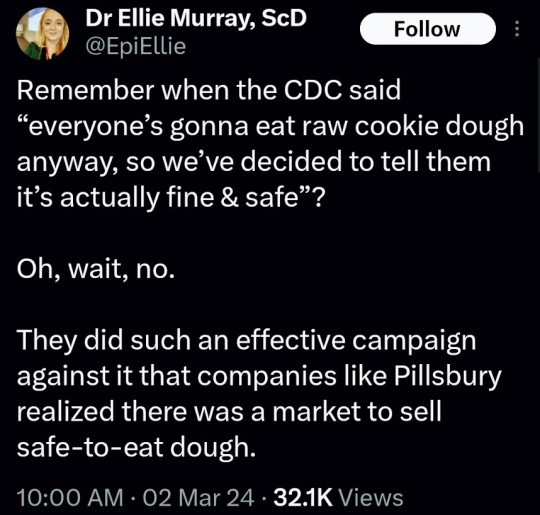
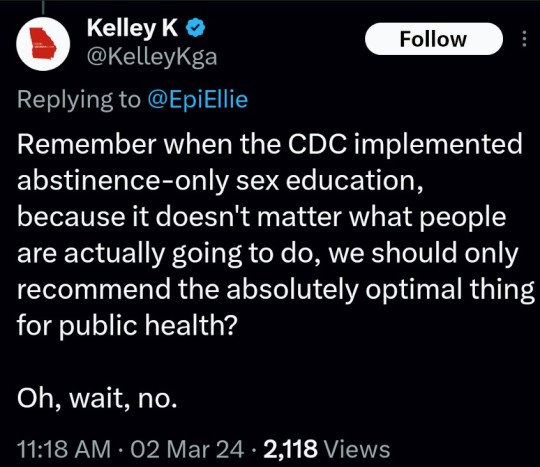
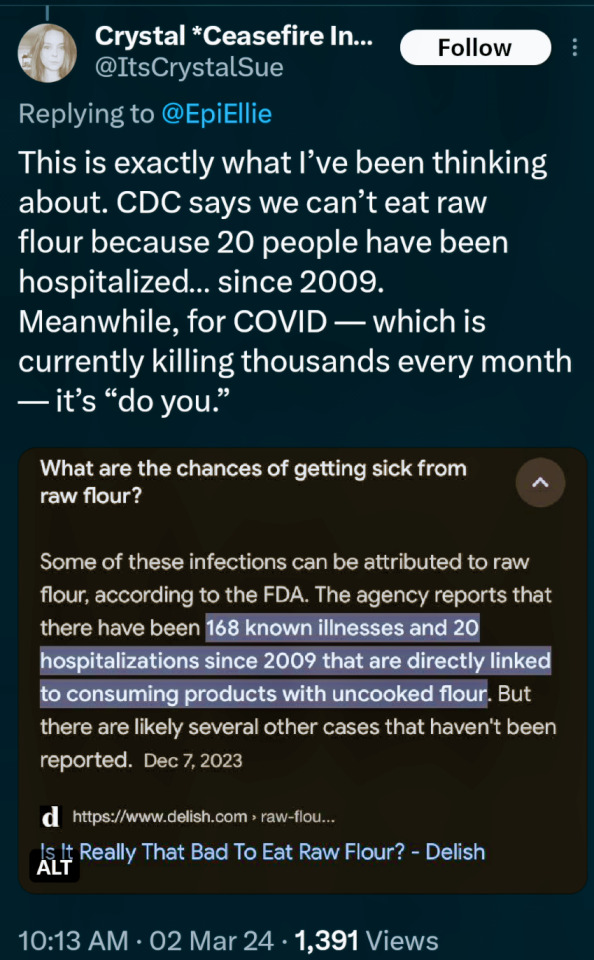
(say no to raw dough: CDC)
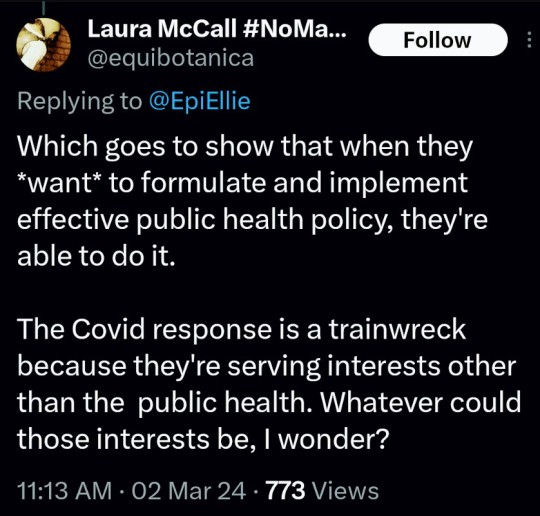
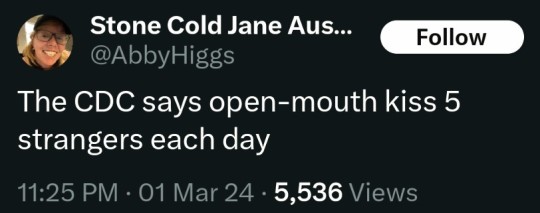
#please stay safe#the vaccines are safe#yes the covid shot is safe#covid is not a hoax#covid causes permanent long term damage to your body even if you're healthy#news#scicomm#science#ars technica#covid--19#coronavirus#beth mole#pandemic#the cdc#centers for disease control#5 day covid isolation#yes you should stay home for at least 5 days if you test positive for covid#Open windows to ventilate indoor space with outdoor air to prevent virus transmission#Wear a mask that doesn't touch your lips#keep distance from others
5 notes
·
View notes
Note
hi isabel friend of gowns this is where the diarrhea posting is coming from (non-cdc) fortune DOT com/well/2024/08/19/covid-guidelines-sick-kids-return-school/ sorry it would not let me send a real link
thanks for this!!!
this article is kinda funky because its headline is about updated guidelines about covid (essentially moving to treat it, when it comes to “should i go to school/work/whatever,” like other respiratory illnesses, about which i do not have the background to have an opinion nor do i tbh trust myself to assess this question in an unemotional light), and then it also talks some about other stuff, because it’s aiming to be a little infodump for parents, but the other stuff is not always cdc related. specifically re: diarrhea, this is where it comes up in the article:

nothing here provides any info about what the cdc says (just the APA and some california school districts - it’s a little confusingly phrased but the thing about older children being able to go to school with mild diarrhea comes from the APA, which, i mean, stresses me out but i am literally not a doctor) sooo thus far it seems also the case that there is no evidence for the cdc updating its guidelines to be more diarrhea chill
5 notes
·
View notes
Text
Health experts warn against COVID complacency in schools amid surge - Published Aug 25, 2024
Health experts are urging school staff and families to take active steps to mitigate the spread of COVID-19 amid rising infections as school districts stick to their previous plans to combat the virus similarly to how they would the flu or strep throat.
Weekly deaths from COVID-19 have steadily risen in the United States since mid-June, according to the Centers for Disease Control and Prevention (CDC) COVID Data Tracker.
And wastewater viral activity for the disease — which is monitored as a means of detecting where a potential outbreak may occur — has gradually climbed since May, with the national level now “very high,” according to the CDC.
The rising rates are having little effect on the start of the school year, however. Schools have largely chosen to treat COVID-19 like RSV or the common flu, at the recommendation of health organizations like the CDC.
“COVID forever changed the landscape of education. As it stands now, in both districts (Meridian CUSD 223 and Oregon CUSD 220) I have the pleasure of leading we are moving forward full steam ahead and treating COVID in the same form and fashion we would treat influenza or strep throat,” said PJ Caposey, superintendent of Meridian School District in Illinois.
“The impact COVID has had on schools and on society cannot be understated, but currently it is not impacting how we operate and serve kids,” he added.
School districts are still feeling tremendous impacts from the coronavirus and the widespread closures it drove earlier in the pandemic, such as students struggling to catch back up academically.
Recent data from nonprofit research group NWEA found that students going into high school are a full year behind academically.
Since the CDC has classified COVID-19 under the umbrella of respiratory illnesses, in the same category as the flu, schools have dropped precautions previously put in place to mitigate the spread of the virus such as masks or social distancing.
Los Angeles Unified School District (LAUSD), for instance, previously had policies requiring students and faculty to stay out of school longer if they contract COVID-19 and to wear masks for a certain period when they came back.
LAUSD posted on social media in August that due to high vaccination rates, COVID-19 will be treated like RSV. The district stressed that those with COVID-19 need to stay home if they have symptoms or a fever and cannot come back until symptoms start improving and the fever is gone for 24 hours without medicine.
Amid the current rise in COVID-19 cases and with another likely surge looming during the fall or winter months ahead, health experts are urging school communities not to become complacent when fighting against the virus’s spread.
The most important thing families and school staff can do to protect themselves is to get vaccinated, according to Jodie Guest, senior vice chair of epidemiology at Emory University’s Rollins School of Public Health.
As of May, only about a quarter of U.S. adults and about 14 percent of children were reported to be up to date on a COVID-19 vaccination, according to CDC data.
The Food and Drug Administration approved updated Moderna and Pfizer COVID-19 vaccines Thursday to more closely target the recent strains of the virus, as well as potential fall and winter variants.
Adults and children 6 months and older are eligible for the updated vaccines, according to the CDC. Children 5 years old and up will need one shot of an updated vaccine to remain current, while children between 6 months and 4 years old might need multiple shots.
The updated shots will likely be on pharmacy shelves within “the coming days.” Those who have recently been infected with COVID-19 can delay getting the updated vaccine for up to three months, per CDC guidelines.
On top of getting the shot, Guest encourages school staff and parents to regularly test themselves and children for COVID-19 infections because testing “still really matters.”
“If your kid comes home and is not feeling well and showing signs that might be COVID, might be something else, going ahead with at-home testing is an important way to stop spread in your family and to stop spread in schools,” she said.
Sick adults and children should test themselves multiple times at home to ensure they do not have the virus, Guest said. If a first at-home antigen test is negative, she recommends taking a second test 36 to 48 hours later “to make sure it’s a true negative.”
School staff members who think they are sick should stay home, health experts agree. Parents should also keep their children home from school if they are sick to reduce the chance of spreading COVID-19 to others.
“If you are sick, stay home. Don’t infect others,” said David Weber, epidemiologist and associate chief medical officer of UNC Health Care.
While COVID-19 infections are typically less severe in children, kids can still suffer complications from contracting the virus, like long COVID, which may appear differently in adolescents than in adults.
Children can also serve as vectors for the virus, potentially spreading it to more vulnerable people like older relatives.
“You really don’t want to bring this home particularly if you have grandparents living with you,” said Andrew Pekosz, a professor at Johns Hopkins Bloomberg School of Public Health who studies respiratory illnesses including COVID-19.
However, it appears unlikely that schools will change their standards to fight COVID-19 without official recommendations from the CDC.
“Schools put measures in place through the COVID-19 pandemic to mitigate the spread of infection including vaccination clinics, cleaning procedures, and mitigation protocols that should be followed just as with any other communicable diseases such as the seasonal flu,” said Jeanie Alter, executive director of the American School Health Association, a group that supports health professionals in schools and advocates for healthy school environments.
“It will be important for schools to review and update these practices and continue with best practice guidance from reputable science-based organizations such as CDC,” she said.
#covid#mask up#pandemic#covid 19#wear a mask#coronavirus#sars cov 2#public health#still coviding#wear a respirator
18 notes
·
View notes